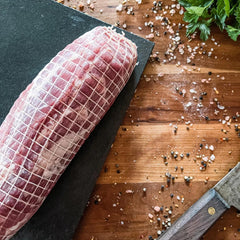The boudin noir is one of the oldest charcuterie products
In France, the boudin noir is one of the permanent staples of French cuisine, particularly north of the country. Simply put, it is one of the most famous and most appreciated and celebrated blood pudding sausages made in France. It has always been part of a tradition of sausage making in the Charcuterie industry. On average, a staggering 15,000 metric tons of boudin noir is being consumed annually by French citizens.
Apart from France, Boudin Noir is also a very popular delicacy in Western Europe, especially in the Low Countries, Germany and Spain.
The main ingredients that go into the preparation of this recipe is pork, pork blood, onions and spices such as nutmeg and coriander (vary per the country/region).
Boudin noir sausage: What is it?
The boudin noir is one of the oldest and among the most traditional meat curing recipes in France. Various inscriptions that document the preparation of boudin noir state that the recipe dates back to the Middle Ages, when it was made with pork blood and oats.
But other sources state that French people and their Gallic ancestors have been preparing and consuming boudin noir for the past 2000 years. Until the Second World War, it was still common for French families in provincial areas to raise pigs and to make it themselves.
In terms of preparing boudin noir, pigs were raised to be slaughtered when winter was around the corner, usually coming late November. This process was regarded as a time-honored tradition at this time of the year, with the entire family or village working from dusk till dawn. In essence, the process was comprised of the following steps:
- Slaughtering the pigs
- Bleeding them
- Butchering their carcass and processing the body parts
During the succession of the aforementioned steps, the families ensured that almost no body parts would go to waste. This represented not only an important source of meat, but also enabled families to stockpile on food during the lean winter month.
As this tradition of saving the family pig for slaughter dwindled down, preparing the boudin noir became less of a necessity of a standard French recipe among many others. Despite the evolution in terms of the methods used to prepare black pudding, boudin noir can be found in practically any butcher shop.
Before being stuffed into its envelope “casing”, the blood is mixed with several ingredients. Of course, the quantity and the type of said ingredients vary from one chef to another. Generally, elements such as herbs, onion, or chestnuts, and apples can be commonly found within said casings.

What is the Boudin Noir Recipe Made Of? Boudin Noir around the world
The preparation of black pudding requires several ingredients, some of which are essential to enjoy its consumption. Once ready, your boudin noir sausage can be served with mashed potatoes and sliced grilled apples. With that being said, keep in mind that the exact recipe for boudin noir can vary depending on the country, the region and the maker. Some variations include the use of other ingredients, such as rice, noodles, breadcrumbs or apples, to give the sausage a different flavor or texture.

Designed by Freepik
The french iteration of boudin noir dispenses with all the lightness and sticks to what is essential to the recipe: the blood and onions. In France, boudin noir is often consumed during the fall and winter months, as a way to perpetuate the tradition of black pudding being prepared during the month of November.
In the United-Kingdom and Ireland, Boudin Noir is more commonly known as black pudding, or blood pudding. It is traditionally made by mixing pork blood with a filler such as oatmeal, barley or breadcrumbs, along with pork fat, onions, fried tomatoes and a variety of seasonings. It is usually served as part of a traditional English or Irish breakfast, or as an accompaniment to a main dish.
In Belgium, boudin noir is often served with fries, which is known as “boudin-friet” amongst local Belgian dialects.
In Spain, boudin noir is known as “morcilla”, and it is a traditional part of the cuisine in the region of Asturias. Morcilla is often served as a tapa, or small plate, and is also a popular ingredient in traditional dishes, such as “fabada”, or bean stew.

Any Health Benefits for the Boudin Noir?
Boudin noir is a high-fat and high-cholesterol edible. Some commercially-produced blood sausages also contain high levels of salt and preservatives. It should thus be consumed in moderation as part of a balanced diet.
That being said, boudin noir also pack some essential health benefits:
-
Boudin noir is a good source of protein and iron: The pork blood used in the sausage contains a high amount of iron, which is an essential mineral that helps to transport oxygen throughout the body and is important for maintaining healthy red blood cells.
-
Boudin noir contains a good amount of Vitamin B12: This vitamin plays a critical role in the production of red blood cells, DNA synthesis and the maintenance of the central nervous system.
-
Blood sausage is a good source of minerals: Boudin noir is rich in minerals such as zinc, copper and manganese, which are essential for many physiological functions like the immune system, and wound healing.
- Boudin noir’s accompaniments also play a role: As previously stated, some traditional recipes of boudin noir include barley or oatmeal, which are good sources of dietary fibers, a healthy gut and prevent constipation.

Designed by Freepik
All in all, if you want to include boudin noir in your diet, the best course of action lies in choosing a high-quality, artisanal iteration that uses natural ingredients.
How to cook boudin noir?
As boudin noir is already cook, you just need to re-heat it. We recommend plating the boudin in a stoneware dish with butter and thin sliced apples. Place it in a hot oven (350F) for about 15-20 minutes. You can serve it with mashed potatoes and caramelized apples or onions. However, so many different cultures have their own recipes and way of consuming blood sausage, "black pudding" in the UK and Ireland is for example typically eaten as breakfast food.
In conclusion, boudin noir is a very popular delicacy across many countries, and has a long history of being enjoyed as a main course or used as an ingredient in many dishes. Not only is it delicious. As you’ve seen in this article, it has a variety of health benefits by being a good source of protein and iron, as well as other essential vitamins and minerals.
As with any food, it should be consumed in moderation and as part of a balanced diet. If you’re looking for a new way to spice up your meals, boudin noir makes for a perfect choice. Whether you’re looking to add some traditional flair to your breakfast, or want to impress your guests with a gourmet dish, boudin noir is sure to please!









